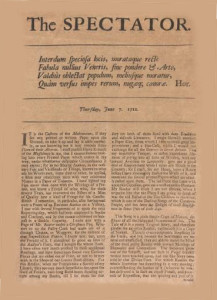Franklin is one of the most accomplished writers in American history, among other things (many other things).
He wrote for newspapers and almanacs, for fun and for diplomacy. He wrote for independence and humor, to start wars and end them. He was a master of words to put it simply, but it wasn’t always this way.
In fact, as a teen, Franklin was quite a poor writer, and his father Josiah let on as much, after reading one of his arguments on the education system. He called his writing unpersuasive and weak.
This didn’t discourage Franklin in the least, but rather galvanized him to master the art of the written word. What’s intriguing is how he did so.
He didn’t have teachers or mentors, at least not in the traditional sense. Instead he learned from reading. Franklin created his own self-improvement course for writing with the help of a volume of the Spectator he had come across.
The Spectator was a daily publication founded by Joseph Addison and Richard Steele that flourished in 1711 and 1712. It featured well argued essays by the founders, which explored the values and meaning of contemporary life. This is what served as Franklin’s textbook if you will.
Franklin would read an essay and take brief notes on the subject material. After a few days, he would sit down to try and recreate the essay in his own words, after which he would compare his work to the original.
Sometimes he would make things harder by jumbling his notes, while other times he would fix the parts that still weren’t good enough. Franklin himself described the process like so:
“…but I sometimes had the pleasure of fancying that in certain particulars of small import, I had been lucky enough to improve the method or the language and this encouraged me to think that I might possibly, in time, become a tolerable English writer of which I was extremely ambitious.”
He certainly accomplished that. What I equate this to in modern times is the concept of stealing like an artist, made famous by designer/writer Austin Kleon.
The premise is to copy others work, those that you aspire and look up to, as a form of practice to master the craft. It isn’t to literally steal their work or take credit or sell things off as your own, but rather as a way to learn a skill and discover your own style, voice, or taste.

I think this is exactly what Franklin accomplished when he went about re-creating the essays in The Spectator. It is also an approach we can all use in our lives to master skills.
You can literally take any skill, from design to coding to writing to speaking and so on, and use this approach to master it.
If we deconstruct the methods of Franklin, we can find three key steps that allowed for learning in this manner.
1. Find work you like
First and foremost you need to find your own textbook of sorts.
If you are a web developer, what are some sites that you love? If you are a writer, what are your favorites books or articles or essays? If you are an artist, what are some of the pieces that speak to you on another level.
Find inspiration and study it. Try to understand what makes it great, what draws you to it. Take notes. It is the concepts and ideas you distill from this study that will guide you in step two.
2. Re-create it
Next you need to try to re-create the source material. You could make an exact copy, but I recommend adding your own twist on it, trying to improve things where you see fit.
This allows for two things: practice and a deeper understanding on what is required to actually achieve the results you desire.
On the surface, we hardly get a true gauge on what it takes to create the final product. We need to get our hands dirty and go through the invisible steps of the process. This is how we learn.
Furthermore, you can allow some time to pass before you start the recreation process, to add a level of difficulty and let the ideas incubate.
3. Evaluate what you made
Finally, once you’ve made your version you need to compare it to the original. What did you do right? What did you do wrong? What did you do better?
The beauty of this process is you get immediate feedback against the source material. You can quickly see what worked and didn’t.
After you identify any areas of improvement, implement those changes and finish the piece.
Then repeat the process. Again. And again. And again.
Tell me and I forget. Teach me and I remember. Involve me and I learn.Benjamin Franklin
Ultimately the outcome of this process is that you not only learn the skill, but you begin to develop an eye for what is good and your own personal taste.
Moreover, what I love about this approach is that it is fully in your control. It’s not about having the right teacher or mentor or situation. Instead, if you have the desire, all you need is examples of good work and you can get started.
There are no excuses. It just takes time and effort. As Franklin says, learning happens through involvement and imitation is an easy place to start.
So if you are trying to master a skill then give imitation a try, because when you compare yourself to the best, you can only get better.
